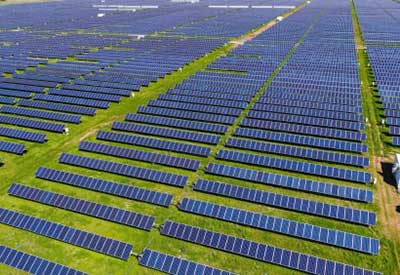Relevance: GS-3: Infrastructure: Energy, Ports, Roads, Airports, Railways etc.
Key phrases: PV cells, Perovskite solar cells
Why in news?
- Scientists from the Indian Institute of Technology, Guwahati, have found a way to make solar panels more efficient
Analysis:
What are Perovskite Solar Cells?
-
A perovskite is a material that has the same crystal structure as the mineral calcium titanium oxide, the first-discovered perovskite crystal. When used to create solar cells, they have shown potential for high performance and low production costs. Perovskite materials offer excellent light absorption, charge-carrier mobilities, and lifetimes, resulting in high device efficiencies with opportunities to realize a low-cost, industry-scalable technology
Perovskite solar cells have shown remarkable progress in recent years with higher conversion efficiency, from about 3% in 2006 to over 25% today.
What Is Solar Energy and Its Advantages?
- The radiation that is received from the sun and utilized in the form electricity and thermal energy by using various available technologies like photovoltaic panels, solar heater etc.
- India lying in tropical belt has an advantage of receiving peak solar radiation for 300 days, amounting 2300-3,000 hours of sunshine equivalent to above 5,000 trillion kWh.
- With its pollution free nature, virtually inexhaustible supply and global distribution, solar energy is very attractive energy resource.
Why this push on Solar by India?
- India is dependent on imports to fulfill its energy demands, thereby incurring huge expenditure and uncertainty with regards to energy security.
- India also needs self-sufficiency and minimal cost in power generation, assured regular supply, which will boost industries and economy.
- The problem of power cuts and unavailability of electricity especially in rural area, leads to improper human development.
- Solar energy is environment friendly. When in use, it does not release CO2 and other gases which pollute the air. Hence it is very suitable for India, India being one of the most polluted countries of the world.
- You don’t need a power or gas grid to get solar energy. A solar energy system can be installed anywhere. Solar panels can be easily placed in houses. Hence, it is quite inexpensive compared to other sources of energy.
Status Of Solar Energy In India
- India has an installed solar capacity of 40 GW which is very low when compared with the target of 100 GW by 2022.
- Solar power capacity has increased by more than 11 times from 2.6 GW five-years back.
Challenges which are holding back Solar Penetration
- India has a very small domestic manufacturing The domestic cell manufacturing in 2019 was meagre 3.1 GW in 2019.
- India’s solar capacity is largely based on imported items. We are heavily dependent on China for PV cells, modules, and other associated products.
- Though the skilling of the workforce is included in the policy support measure for the solar sector, the skilling requirement for the sector is very high and India is not keeping up the pace.
- The High population density doesn’t allow more land to be given away for solar projects. As the upgradation of solar projects need more land, the land paucity is one big challenge.
- The renewable power repurchase arrangement for DISCOMs are not fulfilled due to the already stressed conditions of DISCOMs itself.
Efforts taken by Government for Solar Penetration
- The Ministry has issued Guidelines for Tariff Based Competitive Bidding Process for Procurement of Power from Grid Connected Solar & Wind Power Projects.
- The National Wind-Solar Hybrid Policy has been released to provide a framework for the promotion of large grid-connected wind-solar PV hybrid systems for optimal and efficient utilization of wind and solar resources.
- The MNRE has undertaken a scheme to develop Ultra Mega Renewable Energy power parks (UMREPPs) under the existing Solar Park scheme.
- The VGF scheme for setting up grid-connected solar power is provided through the Solar Energy Corporation of India (SECI).
- PM-KUSUM) scheme was launched in 2019 to provide solar pumps to farmers along with an opportunity to generate solar energy on uncultivable/barren land.
Issue Of PV Cells Availability
- India met 92.11 per cent requirement of its solar equipment through imports in 2017-18-90% from china.
- Higher cost of production- due to lack of integrated set up, economies of scale & modern technology.
- High cost of land/ electricity, low capacity utilization, and lack of skilled workforce.
- India’s attempt to provide a leg-up to local manufacturers through Domestic Content Requirement was thwarted when World Trade Organisation overruled the local sourcing requirements on imports - India then placed a safeguard duty.
Way ahead
- There is a need to improve investment in the solar supply chain within India. As the conventional finance mechanisms are reeling under pressure, measures like green bonds, solar bonds, UNFCCC finance mechanisms can be tried.
- The R&D and skilling of the manpower aspect must be given the most thrust to. If we are to have a robust domestic manufacturing, local R&D and skills are most important.
- State governments must be encouraged to invest in solar energy projects. As seen above, states with higher solar potential must be encouraged through capital grants
Source: Down To Earth









